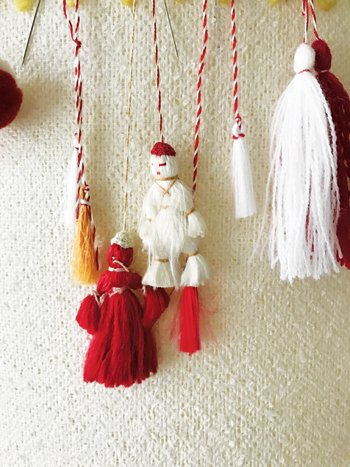IF IT’S MARCH, IT’S MARTENITSI TIME! – Around The Frame

March weather is kind of like November weather; You just don’t know what it’s going to be like from one day to the next. Some days are warm and others are breezy or downright chilly. Both months are harbingers of the month to follow, March with more sun and November with more chill.
For people of the Balkan countries, March is when they wear martenitsi (martinki): small adornments made of red and white yarn worn throughout March or until spring arrives. They can be yarn dolls, yarn balls, tassels, or even braided bracelets. The colors red and white were chosen symbolically, red to ward off disease and white for purity. Though the colors have not changed, their meanings have evolved. Red represents health, fertility, birth, and life. White is symbolic of strength, purity, and happiness. Together they bring health, happiness, new life and longevity along with protection from ill fortune or disease.
The martenitsa roots go back to pagan times, and its folklore has barely changed. It is named for Baba Marta (Grandmother March) an old lady with wild mood swings. The common belief is that by people wearing the red and white tokens, Baba Marta will grant mercy and will bring spring weather.
The hope is that winter will pass faster and spring will arrive earlier. The tradition calls for wearing the martenitsa, also called martinka, until the person sees a stork or a blooming tree. The stork is considered a bellwether of spring—evidence that Baba Marta is in a good mood, has swept in spring with her broom, and is about to retire. Once cut off, the string and yarn bands are traditionally placed on tree limbs so the birds can use them in their nest building.
Two people I know who adhered to the martenitsi tradition were the late Popadia Marilyn Nedelkoff who passed in May 2020 and the late Jordan Lebamoff who passed away in March 2020.
Popadia Marilyn’s husband, the Very Reverend George Nedelkoff, was the priest at St. Nicholas Eastern Orthodox Church first over on Warsaw Street near the Southside Market and later at its new location on Crescent Avenue before his retirement. A very pious woman, Popadia Nedelkoff always hung her martenitsi on a lampshade in her family room according to her niece Shari McConnell who was fond of visiting her Aunt Mimi.
Jordan Lebamoff would wear the simple wrist ones. The way his baba explained it to him, “You were to wear your martinka to speed or usher in the spring. On the first day of spring, you place your martinka on a blossoming tree. IF the mother birds take away and use your martinka to build their nests, they will leave you a gift for your caring and generosity.” Back in March 2012, Jordan’s younger son Julien proudly wore his martinka and on the first day of spring, he placed it up into one of their trees. There he found an iPod as his gift. Julien constantly kept looking in the tree for the bird nest enhanced with his martinka. His father Jordan was buried with his own martinka around his wrist on March 14, 2020. Bog da go prosti.
- The Stars & Stripes Are Forever: Around The Frame - July 5, 2024
- Sam Butcher: A Life Filled With Precious Moments ~ Around The Frame - June 7, 2024
- Aunt Dora & Her Well-Lived Life ~ Around The Frame - May 10, 2024


